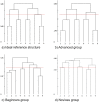Expertise-dependent differences in mental representation metrics of pas de bourrée
- PMID: 37796799
- PMCID: PMC10553204
- DOI: 10.1371/journal.pone.0292133
Expertise-dependent differences in mental representation metrics of pas de bourrée
Abstract
Precise movement control is of prime importance in almost every kind of sport and greatly influences an athlete's performance. In dancing not only motor but also cognitive skills, e.g. in the form of memorized representational structures, are essential components of the performance. This study investigated different metrics related to the long-term memory of ballet dancers with different skill levels regarding the pas de bourrée using the structural-dimensional analysis of mental representations (SDA-M) method. To this end, the Correct Action Selection Probability Analysis (CASPA) algorithm, a recent SDA-M extension that predicts the individual probabilities of correct action selections within a movement sequence, has been applied in the context of dancing for the first time. Significant positive correlations were found between participants' degree of expertise and the proximity of their mental representation structure to the ideal reference structure, as well as between the degree of expertise and the probability of correct action selection within the movement sequence estimated by CASPA. The results indicate that increased training experience in ballet dancing is not only associated with functionally better structured mental representations of the movement sequence but also with a higher probability of correct action selection. These findings provide further evidence for SDA-M with CASPA as an auspicious tool for individualized task-related memory assessments and diagnostics in different action sequences, e.g. as the basis for mental training.
Copyright: © 2023 Wittenbrink et al. This is an open access article distributed under the terms of the Creative Commons Attribution License, which permits unrestricted use, distribution, and reproduction in any medium, provided the original author and source are credited.
Conflict of interest statement
The authors have declared that no competing interests exist.
Figures


References
-
- Schack T, Frank C. Mental representation and the cognitive architecture of skilled action. Review of Philosophy and Psychology. 2021;12(3):527–546. doi: 10.1007/s13164-020-00485-7 - DOI
-
- Bläsing B, Tenenbaum G, Schack T. The cognitive structure of movements in classical dance. Psychology of Sport and Exercise. 2009;10(3):350–360. doi: 10.1016/j.psychsport.2008.10.001 - DOI
-
- Schack T. Measuring mental representations. In: Tenenbaum G, Eklund RC, Kamata A, editors. Measurement in sport and exercise psychology. Champaign, IL: Human Kinetics; 2012. p. 203–214.
-
- Schack T. The cognitive architecture of complex movement. International journal of sport and exercise psychology. 2004;2(4):403–438. doi: 10.1080/1612197X.2004.9671753 - DOI
-
- Weigelt M, Ahlmeyer T, Lex H, Schack T. The cognitive representation of a throwing technique in judo experts–technological ways for individual skill diagnostics in high-performance sports. Psychology of Sport and Exercise. 2011;12(3):231–235. doi: 10.1016/j.psychsport.2010.11.001 - DOI
Publication types
MeSH terms
LinkOut - more resources
Full Text Sources

